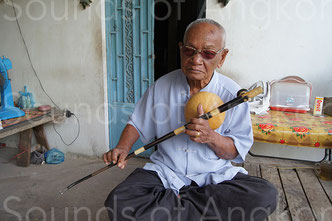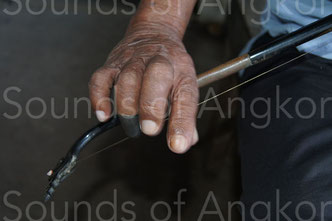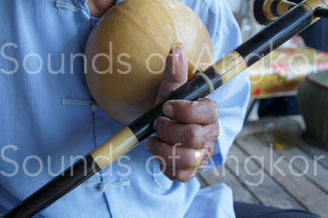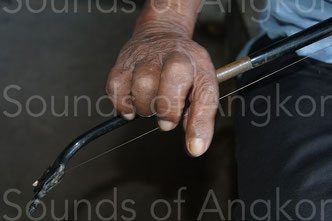Last update: December 5, 2023

The monochord stick zither with a single resonator is called: kse diev ខ្សែដៀវ (pronounced sigh dyoo) or khse muoy ខ្សែមួយ, meaning "one string". The term kse is also transliterated ksae or khsae.
The first iconography in Cambodia dates back to the seventh century, in Sambor Prei Kuk. Its practice had almost disappeared after the genocide of the Khmer Rouge in the 1970s. But thanks to the tenacity of the late Master Sok Duch and the help of Cambodian Living Art, several musicians of the younger generation now ensure its continuation.
Before the revolution, the kse diev was played in the wedding orchestra (plenh kar boran), in the arak orchestra (phleng arak) and sometimes also by blind singers to accompany their singing. This last use is perhaps the secret of its longevity.
Making

The kse diev is composed of a handle turned in wood of neang nuon or kranhung. The end of the instrument is made within a piece of buffalo horn, wood or (formerly) ivory; it's carved in the shape of a nāga's head and fixed to the neck by means of a metal ring. This nāga's head (bangkien) is used to tie the brass string. The other end of the handle is pierced with a hole in which a peg (pranuot ព្រលួត) engages, with which the musician controls the tension of the string and, consequently, the pitch of the fundamental note.
The instrument measures between 80 and 88 cm depending on the manufacturer. The whole is calculated from the total length of the musician's arm if he makes it for himself (from shoulder to fingertip), plus the length of a hand, from wrist to the end of the raised thumb, so that the curvature of the bangkien follows that of the thumb. The length is adapted to the size of the musician in the case of an external order. The handle is in three parts: a 65 cm body made of kranhung wood, a copper or brass tube of 9.5 cm which fits on the handle to a depth of 4 cm, finally the bangkien of 18 cm added of 4 cm that sinks into the metal ring. The peg, in one piece, is shaped by lathe. A half-calabash (khlok) is attached to the handle by a Nylon string (formerly by rattan) passing through the neck of the calabash and attached to a washer in shell of coconut. This large washer keeps the Nylon inside the calabash. Once "screwed", she tightens the handle on the calabash causing a tension on the Nylon. The calabash is fixed on the handle of the instrument to a span of the peg. Other musicians measure the location of the calabash by counting one cubit plus one hand, plus an inch from the bangkien.
The brass string is bought commercially; the musicians thin it step by step in order to obtain the desired diameter. It is attached to the bangkien on the one hand, to the ankle on the other hand, and passes under the gourd's holding wire. The vibrating part of the string is the one that goes from the bangkien to the resonator attachment point.
Playing
The instrument is held in hand, calabash in the center of the chest. The handle is in an oblique position with respect to the body, the peg being, for right-hand musicians at the height of the left shoulder.
The technique of the kse diev is very difficult. The fingers of the left hand (index, middle and ring fingers) press four points of the string near the fastening Nylon to vary the vibrating length of the string.
Vibration is produced by pinching the string at several precise points with a metal and horn tab attached to the right ring finger. The height of the degrees is given by a light touch of the right index finger touching the string at the same time as the miter. The artist can play an octave and a half (12 notes), sometimes two octaves if he is really a virtuoso.
In the orchestra, the vacuum string is usually tuned according on the samleng ko note of the oboe.
By placing the calabash more or less on his chest, the musician can hear with more or less power the harmonics on which he plays.
"Play kse diev" is said "denh kse diev" in Khmer = pluck the monochord.
This article is both a translation and an updated revision by Patrick Kersalé of "L'orchestre de mariage cambodgien et ses instruments" written in 1968 by Jacques Brunet. In: Bulletin de l'Ecole française d'Extrême- Orient. Tome 66, 1979. pp. 203-254.
Calabashes under an arbor. To obtain beautiful specimens, they must not touch the ground during their growth.
Sinat Nhok is was a student of Master Sok Dutch and one of the best kse diev player of the young generation. Here, he plays
Sompong.
Lun Sophanet plays Khmao Bong "My darling".








